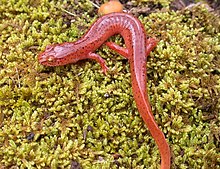Spring salamander
| Spring salamander | |
|---|---|

| |
| Scientific classification | |
| Kingdom: | |
| Phylum: | |
| Subphylum: | |
| Class: | |
| Order: | |
| Family: | |
| Genus: | |
| Species: | G. porphyriticus
|
| Binomial name | |
| Gyrinophilus porphyriticus (Green, 1827)
| |
| Synonyms | |
| |
The spring salamander (Gyrinophilus porphyriticus) is a species of salamander in the family Plethodontidae. The generic name, Gyrinophilus, means "tadpole lover" and refers to the long period of time it spends as a gilled larva before maturing. The specific name, porphyriticus, is Latin from Greek, meaning the color of porphyry, a purple stone,[1] and this salamander has also been called the purple salamander.[2] It is found in Canada and the United States. Its natural habitats are temperate forests, rivers, swamps, freshwater marshes, freshwater springs, inland karsts, and caves. In addition to insects, worms, and other small invertebrates, the fairly large spring salamander may also consume smaller stream dwelling salamanders such as two-lined and dusky salamanders. Although deforestation is a potential threat, the spring salamander occurs in many protected areas and is not listed as threatened in the IUCN Red List.[3]
Description
Like all members of the family Plethodontidae these salamanders have a nasolabial groove. The subspecies G. p. porphyriticus and G. p. duryi can be 4.75–7.5 in (12.1–19.1 cm) long. The record length is 9.125 in (23.18 cm). The light line from eye to nostril is bordered below by gray pigment, but the markings are not always conspicuous. The dorsal coloration varies from salmon or light brownish to pink or reddish. The ground color has a cloudy appearance, and the darker markings are vague. The subspecies G. p. danielsi and G. p. dunni can be 5–7.5 in (13–19 cm). The record length is 8.06 in (20.5 cm). The white line from eye to nostril, bordered below by a conspicuous black or dark brown line, is distinctive. There also may be a dark line above the white line, often conspicuous. The dorsal coloration can be clear reddish, salmon, or orange-yellow marked with black or brown spots or flecks.
Habitat
This species is found in cool springs and mountain springs, but is also likely to be found in any wet depression beneath logs, stones, or leaves in the surrounding forest.
Geographic range
Its distribution ranges from southern Quebec to northern Alabama and extremely northeast Mississippi. There is also an isolated colony in Hamilton County, Ohio. G. p. duryi is present in southern Ohio, eastern Kentucky, West Virginia, and western Virginia. The distribution range of G. p. danielsi is the southern Appalachian Mountains and the adjacent Piedmont from North Carolina to Alabama. G. p. dunni is distributed through the southern portion of the Blue Ridge Province and the Piedmont from southwest North Carolina to eastern to central Alabama. The nominate subspecies, G. p. porphyriticus, occupies the remainder of the geographical range of this species.
Subspecies
- Northern spring salamander (G.p. porphyriticus)
- Kentucky spring salamander (G.p. duryi)
- Blue Ridge spring salamander (G.p. danielsi)
- Carolina spring salamander (G.p. dunni)
References
- ^ Mish, F.C., Editor in Chief. 2004. Merriam-Webster's Collegiate Dictionary, 11th Edition. Springfield, Massachusetts: Merriam-Webster.
- ^ Conant, Roger. 1975. A Field Guide to Reptiles and Amphibians of Eastern and Central North America, Second Edition. Boston: Houghton Mifflin.
- ^ Hammerson, Geoffrey (2004). "Gyrinophilus porphyriticus (Spring Salamander)". IUCN Red List of Threatened Species. Version 2011.1. Retrieved October 16, 2011.
Further reading
- Green, Jacob. 1827. "An account of some new species of salamanders". Contributions of the Maclurian Lyceum to the Arts & Sciences 1: 3–8.
- Conant, Roger, and Joseph T. Collins. A Field Guide to Reptiles and Amphibians of Eastern and Central North America. Third Edition, Expanded. Boston: Houghton Mifflin Company, 1998.
External links
- IUCN Red List least concern species
- Gyrinophilus
- Cave salamanders
- Amphibians of Canada
- Amphibians of the United States
- Fauna of the Northeastern United States
- Fauna of the Southeastern United States
- Cenozoic amphibians of North America
- Extant Pleistocene first appearances
- Pleistocene animals of North America
- Pleistocene United States

